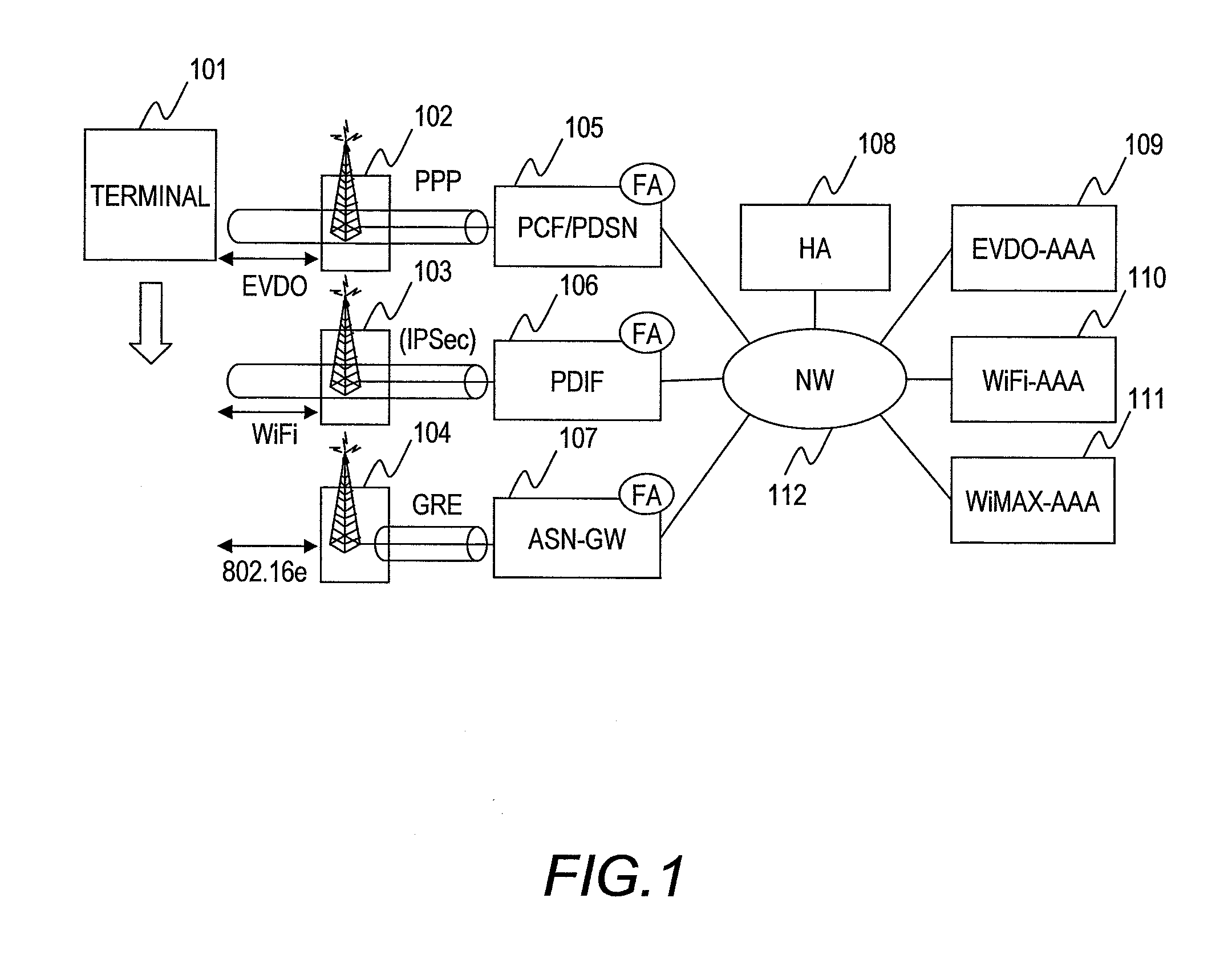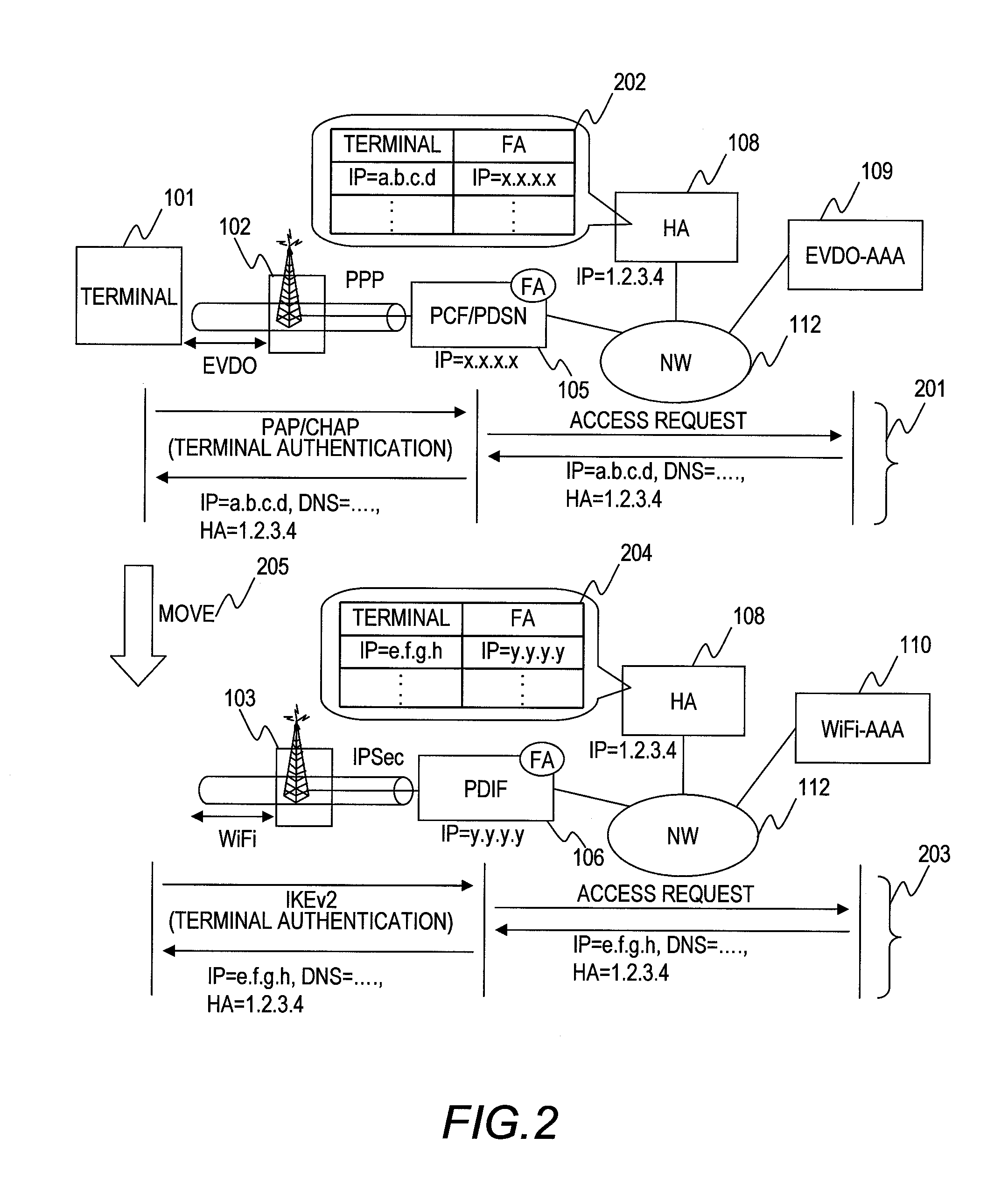Network system and monitoring node
a network system and monitoring node technology, applied in the field of network system and monitoring node, can solve the problems of user throughput, reduced increased network delay, etc., and achieve the effect of improving throughput in the whole system
- Summary
- Abstract
- Description
- Claims
- Application Information
AI Technical Summary
Benefits of technology
Problems solved by technology
Method used
Image
Examples
first embodiment
A first embodiment of this invention will be described. In this embodiment, when a terminal changes wireless systems, the wireless system to be connected from the terminal is determined so as to maximize the system throughput.
FIG. 4 illustrates a configuration of a system in this invention. To grasp the radio conditions of different wireless systems, the system comprises a monitoring node (CMT: Cognitive Monitoring Tool) (404) which collects information about radio from an access point in each wireless system. The information about radio includes received power values, RSSI values, throughputs of users, transmission rate, transmission delay time, packet loss rate, the number of terminals accommodated in an access point, the number of associations with a terminal, processing load at an access point. With respect to EVDO, values of parameters used for scheduling in a wireless zone, such as DRC values and RRI values, are also included in the radio information.
Further, the monitoring no...
second embodiment
Hereinafter, a second embodiment in the present invention will be described. In this embodiment, when the terminal changes wireless systems, the system to be connected from the terminal is determined so that the delay time will be the minimum.
Similarly to the first embodiment, this embodiment employs the system configuration shown in FIG. 4. A wireless system determination process when a terminal AT0 tries to change the connected system from WiMAX to another system will be described.
FIG. 11 illustrates a wireless system determination process by the monitoring node. A part of the steps in the process shown in FIG. 11 are the same as those in FIG. 5; they are denoted by the same reference numerals. The wireless system determination process is triggered when the terminal AT0 tries to change the currently connected WiMAX into another wireless system. Instead of the terminal's changing the wireless system to another, another terminal's try to start connecting to the system may be the tri...
third embodiment
A third embodiment of this invention will be described. In this embodiment, the monitoring node periodically monitors the throughput of each terminal, and if it detects a decrease in the throughput, it determines whether to change the wireless system to accomplish efficient use of communication bandwidth in the whole system.
Similarly to the first embodiment, this embodiment employs the system configuration shown in FIG. 4. The monitoring node periodically measures the throughputs of all of the terminals currently connecting to the system to determine whether to change the wireless system in each terminal.
FIG. 17 illustrates a process of determining the change of the wireless system by the monitoring node. A part of the steps in the process shown in FIG. 17 is the same as those in FIG. 5; they are denoted by the same reference numerals. First, the monitoring node initializes the threshold value of received power and the maximum throughput in each wireless system (1701). Then, it chec...
PUM
 Login to View More
Login to View More Abstract
Description
Claims
Application Information
 Login to View More
Login to View More - R&D
- Intellectual Property
- Life Sciences
- Materials
- Tech Scout
- Unparalleled Data Quality
- Higher Quality Content
- 60% Fewer Hallucinations
Browse by: Latest US Patents, China's latest patents, Technical Efficacy Thesaurus, Application Domain, Technology Topic, Popular Technical Reports.
© 2025 PatSnap. All rights reserved.Legal|Privacy policy|Modern Slavery Act Transparency Statement|Sitemap|About US| Contact US: help@patsnap.com



